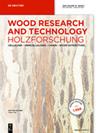Elastic deformation analysis of rotational wood-dowel welding joint system based on the variational method
IF 2.2
3区 农林科学
Q2 FORESTRY
引用次数: 0
Abstract
This study aimed to investigate the elastic deformation of rotational wood-dowel welding joints by using the variational method, as there was no efficient tool to access the deformation behavior of welding joints perpendicular to axis orientation so far. Based on the variational method, the displacement control equation of axially-loaded dowel-welded wood joints was derived. By incorporating the boundary conditions and using an iterative approach, the parameters required in the control equation were determined. The analytical expression ϕ(r) for the deformation function of the wood substrate under elastic conditions was proposed, thereby determining the displacement and axial force of the single wood-dowel. The elasticity modulus was the primary influence parameter on the function ϕ(r). However, the welding depth had a more critical impact, and reasonable combination of parameters could lead to a better interaction between the wood dowel and substrate. The comparison between calculated results and test trials collected from the previous studies indicated that the elastic solution method could accurately estimate the pull-out ultimate bearing capacity and deformation characteristics of the welding joints. This work can provide unique perspective to understand the technology of rotational wood-dowel welding joints, and a good reference suggestion for the manufacture of multi-dowel welding joints.基于变分法的旋转木-道尔焊接接头系统弹性变形分析
由于迄今为止还没有一种有效的工具来获取垂直于轴线方向的焊接接头的变形行为,因此本研究旨在利用变分法研究旋转木榫焊接接头的弹性变形。基于变分法,推导出了轴向加载镙丝焊接木接头的位移控制方程。通过结合边界条件和使用迭代法,确定了控制方程中所需的参数。提出了弹性条件下木质基材变形函数的解析表达式ϕ(r),从而确定了单根木榫的位移和轴向力。弹性模量是影响函数 j(r) 的主要参数。然而,焊接深度的影响更为关键,合理的参数组合可使木钉与基材之间产生更好的相互作用。计算结果与以往研究中收集的试验结果的对比表明,弹性解法可以准确估计焊接接头的拔出极限承载力和变形特征。这项工作可为了解旋转木钉焊接接头技术提供独特的视角,并为制造多木钉焊接接头提供良好的参考建议。
本文章由计算机程序翻译,如有差异,请以英文原文为准。
求助全文
约1分钟内获得全文
求助全文
来源期刊

Holzforschung
工程技术-材料科学:纸与木材
CiteScore
4.60
自引率
4.20%
发文量
83
审稿时长
3.3 months
期刊介绍:
Holzforschung is an international scholarly journal that publishes cutting-edge research on the biology, chemistry, physics and technology of wood and wood components. High quality papers about biotechnology and tree genetics are also welcome. Rated year after year as one of the top scientific journals in the category of Pulp and Paper (ISI Journal Citation Index), Holzforschung represents innovative, high quality basic and applied research. The German title reflects the journal''s origins in a long scientific tradition, but all articles are published in English to stimulate and promote cooperation between experts all over the world. Ahead-of-print publishing ensures fastest possible knowledge transfer.
 求助内容:
求助内容: 应助结果提醒方式:
应助结果提醒方式:


